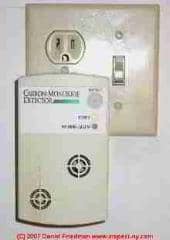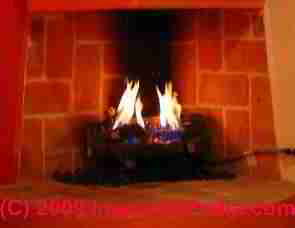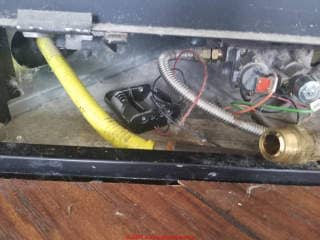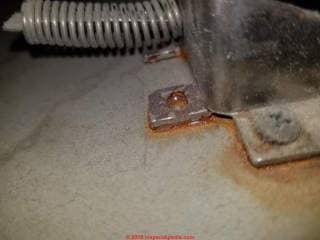 Carbon Monoxide CO Gas Source FAQs
Carbon Monoxide CO Gas Source FAQs
Q&A on possible CO sources in buildings
- POST a QUESTION or COMMENT about testing for dangerous levels of carbon monoxide (CO) gas in buildings including warnings about relying on test instruments
How to perform a visual inspection to check for carbon monoxide hazards:
This article lists visible carbon monoxide gas hazards in buildings: things that you can see during a visual inspection that mean increased risk of carbon monoxide gas (CO) release and poisoning.
This text intends to assist readers in understanding these topics. However it should not be considered complete nor authoritative (no single article is satisfactory); we include additional advice and safety warnings about testing for dangerous carbon monoxide in buildings.
InspectAPedia tolerates no conflicts of interest. We have no relationship with advertisers, products, or services discussed at this website.
- Daniel Friedman, Publisher/Editor/Author - See WHO ARE WE?
Q&A on Inspecting buildings for Conditions Likely to Produce Dangerous Carbon Monoxide

IF YOU SUSPECT CARBON MONOXIDE POISONING GO INTO FRESH AIR IMMEDIATELY and get others out of the building, then call your fire department or emergency services for help. Links on this page also direct the reader to carbon dioxide gas information in a separate document.
Seek prompt advice from your doctor or health/safety experts if you have any reason to be concerned about exposure to toxic gases.
[Click to enlarge any image]
On 2019-05-02 by Anonymous - rumbling water heater, headaches, red face, trouble thinking & talking - CO or other hazard?
RE-posting from private email:
Anonymous said:
I moved into a live work space that has a water heater in the center of the room. It is constantly on rumbling for hours and hours. This has gone on more than usual the past week and I notice I get a headache, my face is read all the time and I have a hard time speaking clearly.
There is a C02 monitor so it isn't gas. I was wondering if there could be soemthing else I am exposed to like electromagnetics that sleeping or sitting as I have to being in a small close space? I feel like my head is inflammed. Thoughts? - Anonymous
Moderator replied: do not assume that there is no CO hazard
Watch out: You describe a possibly dangerous, even fatal situation, particularly if there are flue gases, combustion gases, or similars hazards where you are living.
To make a more useful comment we'd need to know
Location: country and city
Type of water heater: electric, oil, gas
Fresh air sources: windows, outdoor air duct, nothing
In general it is unsafe, and illegal in most jurisdictions, to place a fuel-fired (gas or oil) water heater in a sleeping area. \
Electromagnetic fields would not explain your symptoms.
DO NOT assume that there is no dangerous CO present (your monitor would be for carbon monoxide or CO, NOT CO2 - carbon dioxide) - as we do not know that your CO monitor is working, properly-located, tested.
Check with your doctor and follow her advice.
If you feel that your sleeping area is making you sick or exposing you to carbon monoxide you should get out immediately and ask for help. If there are other people in the building they too could be at risk and need to be warned.
Also see
GAS BURNER FLAME & NOISE DEFECTS where we explain that some gas burner noises may mean the heater is unsafe
NOISE, WATER HEATER where we explain that scale can cause rumbling noises at a water heater
On 2018-07-12 by Anonymous - The tinnitus, hearing loss, balance issues, numbness and cognitive decline
 Thank you. There is a semi close expert near me so I'll give it a try. Attached is a picture of where the natural gas leak was.
Thank you. There is a semi close expert near me so I'll give it a try. Attached is a picture of where the natural gas leak was.
I know the symptoms I had and am recovering from doesn't fit with the natural gas. The blower down there was covered with debris. I'm pretty sure it was co poisoning, but obviously not completely.
The tinnitus, hearing loss, balance issues, numbness and cognitive decline was constant.
The first symptoms started in September the day after I was hit with a severe headache and nausea that put me in bed for 48 hours.
The 1st neurologist I saw couldn't find anything wrong. After the second time in the hospital I got another neurology appointment where I was told that it was absolutely not possible to get carbon monoxide poisoning from a gas fireplace.
This went on from September last year until the beginning of May when the gas was shut off. My hope is to get a doctor to look at it as a possibility and if the remaining cognitive problems and breathing issues could be from this.
On 2018-07-11 by (mod) - CO hazards at gas log fireplaces
Anon
I understand both the anxiety over having traced illness to some uncertain source in building and the confusion that comes from confounding multiple possible problems.
Most modern gas log fireplaces include oxygen sensors or other safety devices that will turn off the appliance.
Similarly, on other gas appliances in many jurisdictions the use of spill switches is required - such as at water heaters and gas furnaces or boilers.
If you're in the U.S. take care that the present government may, if it follows its other environmental, health, and safety choices and preferences to date, reduce or remove the requirement for such safety protection devices. But you can still insist on them as a consumer.
Carbon monoxide exposure might indeed be traced to an improperly-operating or improperly-vented gas appliance, including a gas fireplace.
I have tested a number of gas log fireplaces that were claimed by their manufacturer to be rated for un-vented indoor use (outside the U.S. in this case) and every one of them produced enough CO to eventually set off a nearby carbon monoxide detector. We had to install fan boosted venting to stop such problems.
But a "gas leak" - if you mean fuel gas such as LP or natural gas - is NOT Carbon Monoxide and would be a completely different safety hazard (risking fire or explosion or its own IAQ issues. The connection between a fuel gas leak and high CO *might* be one in which the leak also was associated with improper burner operation and the production of CO.
Similarly, lint accumulation might be normal in a building.
At the EXPERTS DIRECTORY link found at the top of any InspectApedia.com page you can find sources of environmental test experts and home inspectors, some of whom have the expertise you need.
 Be sure to discuss the individual's specific expertise and experience as well as what inspection and tests they might use and what written report and follow-up advice they will provided. No single certification is going to guarantee that you'll receive those.
Be sure to discuss the individual's specific expertise and experience as well as what inspection and tests they might use and what written report and follow-up advice they will provided. No single certification is going to guarantee that you'll receive those.
Beware of an expensive "consultant" who will simply stop by and conduct a "test" - pretty much not very helpful.
Beware of an inexpensive "consultant" who is cheap and delivers too little.
See HOW MUCH SHOULD YOU PAY
On 2018-07-11 by Anonymous - advice on a gas log fireplace
I could use some advice on a gas log fireplace. I recently found out that I was intermittently being exposed to carbon monoxide for months. Severe neurological symptoms and episodes that put me in the hospital lasted for several months until I found a gas leak.
Before I hire someone to come inspect, I was hoping to get advice on what kind of certifications or experience they should have.
Also if anyone has input on some information and photos that could or could not be a factor. At the same time I found the gas leak I also found out that my dryer had been venting in my crawl space.
There was lint all over down there. I found some under the firebox where the shut off valve and leak was. I don't know how but it was in the exhaust fans in the bathroom and the furnace air intake on the ceiling was completely blocked.
On 2018-05-20 by (mod) - Increased danger of fatal carbon monoxide poisoning from cars left running in garages
Increased danger of fatal carbon monoxide poisoning from cars left running in garages was pointed out by David Jeans and Majlie De Puy Kamp in
- "Keyless Cars Turn Tiny Lapses into Invisible Clouds of Death", The New York Times, 14 May 2018 p. A1, A14.
The authors note that the combination of keyless cars that use a key fob and a car start/stop button in place of an ignition key, combined with very quiet motors in modern vehicles has resulted in increased deaths from carbon monoxide poisoning. Drivers arrive home, drive into the garage, close the garage door, get out of and walk away from their quietly-running car.
While the number of deaths is almost certainly greater than those reported to authorities, the Times identified 28 deaths in the U.S. ascribed to this cause since 2006.
The cost to "fix" the problem by adding a more-noticeable "car left running" alarm or to automatically turn off the car engine after a time, would be trivial according to the authors.
Question: tracking down concerns for Carbon Monoxide Exposure
2019/05/01 Anonymous wrote
I moved into a live work space that has a water heater in the center of the room. It is constantly on rumbling for hours and hours. This has gone on more than usual the past week and I notice I get a headache, my face is read all the time and I have a hard time speaking clearly.
There is a C02 monitor so it isn't gas. I was wondering if there could be soemthing else I am exposed to like electromagnetics that sleeping or sitting as I have to being in a small close space? I feel like my head is inflammed. Thoughts? - Anonymous by private email
Reply: don't confuse carbon dioxide (CO2) with carbon monoxide (CO) - your detector will be for CO
Watch out: You describe a possibly dangerous, even fatal situation, particularly if there are flue gases, combustion gases, or similars hazards where you are living.
To make a more useful comment we'd need to know
Location: country and city
Type of water heater: electric, oil, gas
Fresh air sources: windows, outdoor air duct, nothing
In general it is unsafe, and illegal in most jurisdictions, to place a fuel-fired (gas or oil) water heater in a sleeping area. \
Electromagnetic fields would not explain your symptoms.
DO NOT assume that there is no dangerous CO present (your monitor would be for carbon monoxide or CO, NOT CO2 - carbon dioxide) - as we do not know that your CO monitor is working, properly-located, tested.
Check with your doctor and follow her advice.
If you feel that your sleeping area is making you sick or exposing you to carbon monoxide you should get out immediately and ask for help. If there are other people in the building they too could be at risk and need to be warned.
FYI information about carbon dioxide is found separately
Reader follow-up: The manual for my water heater says for closet installation
2019/05/02
Thank you for your swift reply
Location: country and city I live in the lord of the flies capitol, Missoula MT and landlords and principalites would rather have fixed income tenants die than thrive much less the landlords and the city do the right thing...it is unlikely they will follow federal law as even those who are supposed to be advocates, give "respectable"" violators a free pass...it is hard finding housing. I don't know what to do. I will keep doors open much as I can.
Type of water heater: electric, oil, gas
It is a Bradford White Defender safety hydrojet
Model M15036FBN
Serial: JB16302694 D/N 700
The manual says for closet installation
From the center of the cylindar that is the water heater is a fat silver pipe that goes up and over. Other than than far as I can tell there is no vent. I have one window and being cold I kept it closed and my head swelling started. Last night I slept in my bathroom which helped.
Fresh air sources: windows, outdoor air duct, nothing. The past few months my spelling has deteriorated.
I tried finding my post on the site in order to redact it.. and can't navigate that well. I will try or if you are able, you have my permission. And thank you so much. I moved here from another hell hole where the property manager pooh pooed my concerns so I was doubting myself. You saved my life, I think.
Reply: notify building owners in writing of unsafe conditions
Sometimes if you notify landlord in writing of an unsafe condition the fact that it's written down is taken seriously enough that they'll do what they need to do.
Reader follow-up:
Thank you
I will provide them a written notice of the hazard that water heater is being in an open floor plan. Sorry for rambling on in my prior email. God Bless.
Reply:
keep me posted, and take care - they may just try to evict you
In most jurisdictions, while leases mostly protect the property owner, there are usually lease laws that require the landlord provide safe, habitable residence
Reader follow-up: is tinnitis a symptom of CO poisoning?
Thank you for your reply
I have ringing in my ears constantly. Is that a symptom?
A friend came in and said she could not smell gas. I am sure that is why everyone will do because they are not as sensitive as I am. This town is pro landlord and tenants have no rights..I talked with the Human Rights investigator about the last place I moved out of that had mold, he told me he was not there to help me....just to dot i ' s and cross t s.
I told the neighbors upstairs that have three young children, one a baby and they don't notice anything.
There is no smell, I just am having these reaction. I called the city and it is Friday. I hope to hear back from the city inspector. I realize I might be evicted for wanting my residence not to kill me. I am sleeping in the bathroom which seems separate.
I am trying to figure out what to do..and I will keep you posted.
Reply: International Residential Code 2009 on prohibited water heater locations
Common symptoms of carbon monoxide exposure are headache, nausea, rapid breathing, weakness, exhaustion, dizziness, and confusion. - U.S. CDC
The most common symptoms of CO poisoning can be confused with “flu-like” symptoms—such as headache, dizziness, weakness, upset stomach and vomiting.
It can also cause sleepiness, blurred vision, ringing in the ears, breathing problems, and confusion. - Vermont DOH, retrieved 2019/05/23, original source: http://www.healthvermont.gov/health-environment/healthy-homes/carbon-monoxide
FYI from the International Residential Code 2009
70. LPG APPLIANCES.
Section M2005 IRC 2009 M2005.2 Prohibited locations [for fuel fired water heaters]
Fuel-fired water heaters shall not be installed in a room used as a storage closet.
Water heaters located in a bedroom or bathroom shall be installed in a sealed enclosure so that combustion air will not be taken from the living space.
Direct-vent water heaters are not required to be installed within an enclosure.
M2005.2.1 Water heater access.
Access to water heaters that are located in an attic or under floor crawl space is permitted to be through a closet located in a sleeping room or bathroom where ventilation of those spaces is in accordance with this code.
Reader follow-up: my city doesn't respond to my carbon monoxide worry
Wow, thank you for this information. The water heater manual says it should be in a closet as well. I will keep it in mind as I may have to move out because I feel unwell in this place. The difficulty is there are no options ... it is as if they want those who don't want to apply for section 8 and who are not rich should erase themselves from this plane of existence.
...
I called the city about the water heater safety and received no reply. I called back and referred to another department that didn't even have an answering machine. I am thinking they let property managers kill tenants so they get that deposit money easy.
When I brought this situation up to therapist types, they suggested maybe I was too sensitive to the carbon monoxide.
Reply: pursue appropriate medical help for CO exposure concerns, diagnosis, effects, treatment
I trust you to understand that nobody can diagnose CO poisoning nor psychological questions nor CO sensitivity by text message. You need to find a doctor you trust and then trust that doctor's advice.
You are welcome to pass on to the therapists who told you that you are "too sensitive to carbon monoxide" my OPINION that such a diagnosis, based on talk therapy, risks killing someone - surely your therapist would agree that no one should attempt to diagnose toxic or fatal gas exposure by talking about it.
However IF experts inspecting and testing your home are NOT finding CO at detectable levels
AND IF the inspectors are confident that there has been enough monitoring and testing that there's no reasonable risk that there are episodic surges in the CO level indoors
THEN a therapist might help you sort out the question of whether or not you've become distracted by a specific worry about carbon monoxide and that you ought to be discussing other possible mental and physical health concerns.
You are welcome to print out CARBON MONOXIDE - CO
or any other InspectApedia.com article
and share that with your therapist as well as anyone else who's interested.
Here are the CO exposure limits for the workplace as provided by the US CDC:
CO Exposure Limits
NIOSH REL - TWA 35 ppm (40 mg/m3) C 200 ppm (229 mg/m3)
OSHA PEL - TWA 50 ppm (55 mg/m3)
- https://www.cdc.gov/niosh/npg/npgd0105.html
CO Exposure symptoms
Headache, tachypnea, nausea, lassitude (weakness, exhaustion), dizziness, confusion, hallucinations; cyanosis; depressed S-T segment of electrocardiogram, angina, syncope
CDC details on Carbon Monoxide Poisoning
Carbon monoxide (CO) is a colorless, odorless, and toxic gas, which is predominately produced by incomplete combustion of carbon-containing materials. Incomplete combustion occurs when insufficient oxygen is used in the fuel (hydrocarbon) burning process. Consequently, more carbon monoxide, in preference to carbon dioxide, is emitted.
Some examples of this are the following: vehicle exhausts, fuel burning furnaces, coal burning power plants, small gasoline engines, portable gasoline-powered generators, power washers, fire places, charcoal grills, marine engines, forklifts, propane-powered heaters, gas water heaters, and kerosene heaters.
Exposure to carbon monoxide impedes the blood’s ability to carry oxygen to body tissues and vital organs.
When carbon monoxide is inhaled, it combines with hemoglobin (an iron-protein component of red blood cells), producing carboxyhemoglobin (COHb), which greatly diminishes hemoglobin’s oxygen-carrying capacity. Hemoglobin’s binding affinity for carbon monoxide is 300 times greater than its affinity for oxygen.
As a result, small amounts of carbon monoxide can dramatically reduce hemoglobin’s ability to transport oxygen.
Common symptoms of carbon monoxide exposure are headache, nausea, rapid breathing, weakness, exhaustion, dizziness, and confusion.
Hypoxia (severe oxygen deficiency) due to acute carbon monoxide poisoning may result in reversible neurological effects, or it may result in long-term (and possibly delayed) irreversible neurological (brain damage) or cardiological (heart damage) effects.
Carbon monoxide exposure can be dangerous during pregnancy for both the mother and the developing fetus. Please contact CDC-INFO (800-232-4636) if you have any questions regarding carbon monoxide exposure during pregnancy.
OSHA comments from the January 19, 1989 Final Rule on Air Contaminants Project extracted from 54FR2332 et. seq.
This rule was remanded by the U.S. Circuit Court of Appeals and the limits are not currently in force.
CAS: 630-08-0; Chemical Formula: CO
OSHA’s former limit for carbon monoxide was 50 ppm as an 8-hour TWA. The ACGIH has a TLV-TWA of 50 ppm with a TLV-STEL of 400 ppm. NIOSH (1973d/Ex. 1-237) recommends an 8-hour TWA limit of 35 ppm with a 200-ppm ceiling. The proposed PEL and ceiling were 35 ppm and 200 ppm, respectively; NIOSH (Ex. 8-47, Table N1) concurs that these limits are appropriate, and they are established in the final rule. Carbon monoxide is a flammable, colorless, practically odorless gas. - https://www.cdc.gov/niosh/pel88/630-08.html
...
Continue reading at CARBON MONOXIDE INSPECTION - topic home, or select a topic from the closely-related articles below, or see the complete ARTICLE INDEX.
Or see these
Carbon Monoxide Gas Articles
- CARBON MONOXIDE - CO
- CARBON MONOXIDE WARNINGS: HOME HEATERS
- GAS DETECTION INSTRUMENTS
- GAS EXPOSURE EFFECTS, TOXIC
Suggested citation for this web page
CARBON MONOXIDE INSPECTION FAQs at InspectApedia.com - online encyclopedia of building & environmental inspection, testing, diagnosis, repair, & problem prevention advice.
Or see this
INDEX to RELATED ARTICLES: ARTICLE INDEX to GAS HAZARDS in BUILDINGS
Or use the SEARCH BOX found below to Ask a Question or Search InspectApedia
Ask a Question or Search InspectApedia
Try the search box just below, or if you prefer, post a question or comment in the Comments box below and we will respond promptly.
Search the InspectApedia website
Note: appearance of your Comment below may be delayed: if your comment contains an image, photograph, web link, or text that looks to the software as if it might be a web link, your posting will appear after it has been approved by a moderator. Apologies for the delay.
Only one image can be added per comment but you can post as many comments, and therefore images, as you like.
You will not receive a notification when a response to your question has been posted.
Please bookmark this page to make it easy for you to check back for our response.
IF above you see "Comment Form is loading comments..." then COMMENT BOX - countable.ca / bawkbox.com IS NOT WORKING.
In any case you are welcome to send an email directly to us at InspectApedia.com at editor@inspectApedia.com
We'll reply to you directly. Please help us help you by noting, in your email, the URL of the InspectApedia page where you wanted to comment.
Citations & References
In addition to any citations in the article above, a full list is available on request.
- In addition to citations & references found in this article, see the research citations given at the end of the related articles found at our suggested
CONTINUE READING or RECOMMENDED ARTICLES.
- Carson, Dunlop & Associates Ltd., 120 Carlton Street Suite 407, Toronto ON M5A 4K2. Tel: (416) 964-9415 1-800-268-7070 Email: info@carsondunlop.com. Alan Carson is a past president of ASHI, the American Society of Home Inspectors.
Thanks to Alan Carson and Bob Dunlop, for permission for InspectAPedia to use text excerpts from The HOME REFERENCE BOOK - the Encyclopedia of Homes and to use illustrations from The ILLUSTRATED HOME .
Carson Dunlop Associates provides extensive home inspection education and report writing material. In gratitude we provide links to tsome Carson Dunlop Associates products and services.

